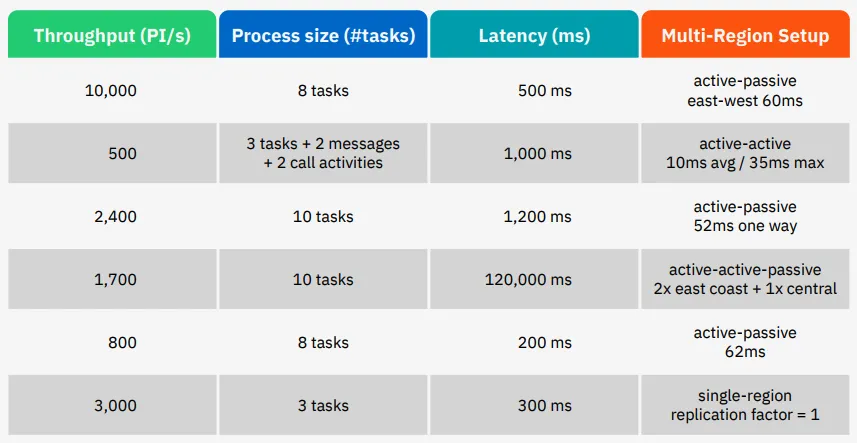There are many technical reasons (previously covered in the “Why Migrate from Camunda 7 to Camunda 8” blog) why migrating to Camunda 8 can bring your company significant technical value, but there are also important business advantages to migrating as well.
Camunda enables organizations to streamline their business processes and workflows, leading to substantial cost savings and enhanced customer experiences for those implementing extensive process automation. Camunda fosters greater flexibility, agility, and performance, allowing organizations to swiftly realize value from their operations.
Why businesses choose to migrate
Although you can achieve some of these rewards with Camunda 7, many of them are only available through the use of Camunda 8. Let’s walk through how organizations are finding that migration to Camunda 8 is great for their business.
Solution acceleration
One of the keys to a successful business is the ability to accelerate your ability to build quality solutions.
With Camunda 7, the solution builders are most often developers and they can get you only part of the way to full solution acceleration. Effective collaboration with various departments is crucial, and utilizing tools such as Connectors and Form Builders, along with additional low-code features, is key. These low-code tools streamline the development workflow, thereby decreasing the time required to develop and launch process solutions. This approach enables a faster and more efficient release cycle for your business projects.
Camunda provides many Camunda Connectors within the modeler and in our Camunda Marketplace. In addition, Camunda customers have access to a wide range of partner-created Connectors as well to help accelerate solution development.
These solution accelerators enhance your business’s agility and adaptability, enabling you to swiftly respond to changing market demands while maintaining ongoing support for your operations. Organizations save over 20,000 hours of development with solution accelerators. By accelerating innovation, you position your business to seize upon opportunities, gain a competitive edge, and win in your marketplace.
Unifying business and IT
Camunda 8 offers enhanced collaboration features that enable your entire organization, not just the IT department, to embrace process orchestration. Camunda’s Web Modeler allows organizations to enable enriched collaboration opening models up to multiple departments based on security information. This wider aperture helps garner support from business leaders who recognize the significance and benefits of orchestration for the business. Without expanding beyond the confines of IT, your organization will be unable to advance to more sophisticated stages of the Process Orchestration Maturity Model, which is vital for your business’s growth, efficiency, and competitiveness.
By adopting Camunda 8, companies can streamline their business processes, significantly boosting overall efficiency. IT teams benefit from heightened agility, which in turn promotes a more productive collaboration with business stakeholders.
As a senior manager of finance at a Camunda customer conveys:
“Firstly, Camunda uses open technology, so we don’t really have a bottleneck in terms of specialty [skills]. Secondly, we can let the business own the business processes. We give [business stakeholders] the power to change processes as they wish, and that adds agility. … Our business partners drive a lot of innovation.”
This synergy allows for rapid refinement of processes, outpacing what is possible with other systems. The swift deployment of new processes not only elevates the customer experience but also contributes to capturing new business opportunities, ultimately driving enterprise growth.
AI innovations
Camunda 8 has a strategic focus on Artificial Intelligence (AI) integration, which means that transitioning from Camunda 7 to 8 places your organization at the forefront of AI technology. This shift promises accelerated collaboration, improved process efficiency, and greater insight into your business operations.
Camunda 8 includes Connectors for OpenAI, which not only facilitate the generation of text but also streamline the input screening and support the automation of certain decision-making processes. For detailed information on how the OpenAI Connector can optimize human workflows, please see Using the OpenAI Connector to facilitate human workflows.
The application of AI, however, is not limited to these functions. AI can revolutionize a wide variety of business processes and overall process solutions. Whether it’s creating user interfaces, aiding in decision-making, or detecting fraudulent activities, AI implementation reduces the margin of error, quickens operational cycles, and increases the accuracy of your processes. The adoption of AI allows for the automation of more processes, leading to smooth and efficient business functions.
Additionally, Camunda 8 offers machine learning (ML) ready datasets, which incorporate process data into your ML models, providing a comprehensive view of your business and enabling faster, more informed decision-making.
For further insights into how AI can enhance your business processes, explore our resource, “How Artificial Intelligence Can Enhance Your Business Process.”
Agility and time to value
Migrating to Camunda 8 can play a crucial role in helping businesses accelerate their time-to-value by improving efficiency, productivity, and innovation. We have already mentioned many tools that contribute to minimizing your time-to-value including AI innovations and Connectors, but there are others.
Companies that have adopted agile methodologies and DevOps practices reduce time from concept to deployment. With Camunda 8, organizations can implement automated CI/CD pipelines to streamline the development and release process to ensure quick and reliable software delivery.
One of our Camunda customer’s enterprise architects noted that:
“Agility is actually the most important factor from a business perspective. [With Camunda,] we can build features and deploy quickly.”
Camunda is known for its open architecture and adherence to standards. Camunda 8 is designed to be an open-source and source-available platform that allows organizations to model, automate, and optimize their business processes.
One Camunda customer states:
“[Our speed now] is a result of [Camunda’s] open technology because there’s a lower barrier to get into it. We can help to enable you, but you can learn it yourself. And then we don’t have a bandwidth issue. That’s a really big saver.”
Customers have noted that development time has decreased by 45% to make process changes.
With an open-source platform, companies are not locked into a proprietary solution. In addition, this openness encourages collaboration and innovation within the community.
Camunda also embraces industry standards like BPMN (Business Process Model and Notation) and DMN (Decision Model and Notation). These standards provide a common language and framework for describing and managing business processes.
In a recent interview, a Camunda customer said:
“Now, it’s easy. … It’s easy for us to manage [business] rules within DMN. And changing the business process — what is out there in production — [is easy]. … [Using Camunda] is easier for both sets of domain experts. Engineers find it very easy to collaborate with the business people, and business [users find] it very easy to collaborate with the engineering folks … because they are both speaking the same language.”
With Camunda’s extensibility through our APIs, developers can integrate the platform with different systems and tools. This flexibility is essential for organizations that may have existing technologies in place. The integration capabilities of Camunda 8 with a wide selection of Connectors―both within the product and available in our Camunda Marketplace―allow companies to leverage their existing IT infrastructure and data sources easily.
Because of this openness and our implementation approach, Camunda 8 supports a microservices architecture and containerized environments. This enables organizations to deploy and scale their process solutions in a more modular and flexible fashion emphasizing the flexibility and agility to pivot easily to meet market demands.
In summary, the investment of migrating to Camunda 8 contributes significantly to accelerating time-to-value for businesses by enhancing efficiency, streamlining processes, and fostering innovation across various aspects of their operations.
Unlock business value at scale
With real-time monitoring with Operate and Optimize, your company has visibility into process execution, allowing you to monitor the performance of workflows and identify bottlenecks. Data analytics help companies gain insights into process efficiency, enabling data-driven optimizations for continuous improvement.
Observing trends in your business processes is key to agility. For example, if you have an issues resolution process and you find that there is an increase in issues related to a single component of your product, you can circumvent additional claims by using this information to proactively reach out to customers who have this product or part in advance to improve customer service and enhance customer loyalty.
Customers interviewed in a recent Forrester study indicate that they have increased their customer satisfaction, collectively yielding $57.8 million in profits. Processes orchestrated by Camunda provide better customer service and higher customer retention rates.
Cloud-native―build for the future
Camunda 8 also offers a SaaS option, which features a cloud-native deployment for customers using containerization to enhance scalability allowing companies to adapt to growing workloads without significant infrastructure changes. Customers cannot get this cloud-native deployment with Camunda 7, making migration even more enticing.
An enterprise architect at one of our customers summed this up very well:
“We are building for the future. We don’t want to build it again in another 15 years, right? … And this was achievable using Camunda.”
Cloud-native applications are designed for high availability including built-in redundancy and failover mechanisms. This helps to ensure that applications remain accessible even if you experience a hardware failure or other issues.
The chart below provides some examples of performance metrics from some of Camunda’s customers.

You can also optimize your resources with Camunda SaaS. The use of containers enables consistent deployment across different environments, reducing compatibility issues and ensuring resource efficiency.
As previously noted, cloud-native applications can easily integrate with emerging technologies such as artificial intelligence, machine learning, and the Internet of Things (IoT), enabling businesses to stay competitive and innovative.
Note: You can implement Camunda 8 Self-Managed if that fits better in your architecture. With this approach, you can implement multi-tenancy in your architecture which provides scalability, cost savings, increased efficiency, and simplifies management and maintenance.
By adopting cloud-native Camunda SaaS, your business is positioning itself with the flexibility, speed, and efficiency needed to navigate the rapidly changing business landscape. It empowers organizations to focus on innovation, respond to market demands quickly, and scale operations seamlessly.
Stay tuned for more migration information
We want to make any migration efforts as easy for you as possible, and we will be providing additional information about the migration process and tools we have to assist you and your organization make this transition.
In the meantime, check out these migration resources:
- Migrate to Camunda 8
- Migrate from Camunda 7
- Migrating a Process Solution from Camunda Platform 7 to 8 (video)
- Camunda 7 to Camunda 8 Transition – a Guide for Architects and Technologists (video)
- Two Approaches for a Smoother Camunda 7 to Camunda 8 migration
Keep an eye out for our next blog on our migration methodology. If you are interested in migrating and want assistance from Camunda, be sure to reach out to Camunda Consulting.
Note: Quotes above can be found in the The Total Economic Impact™ Of Camunda For Enterprises, a commissioned study conducted by Forrester Consulting on behalf of Camunda.


Start the discussion at forum.camunda.io